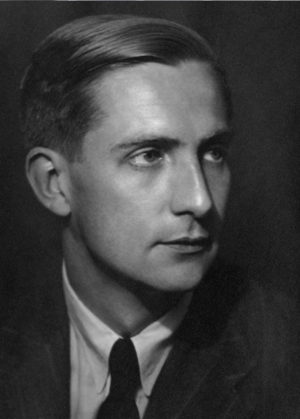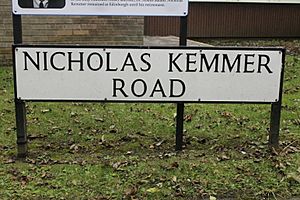Nicholas Kemmer facts for kids
Quick facts for kids
Nicholas Kemmer
|
|
|---|---|
 |
|
| Born | 7 December 1911 |
| Died | 21 October 1998 (aged 86) Edinburgh, United Kingdom
|
| Nationality | British |
| Citizenship | British–German–Russian |
| Alma mater | University of Göttingen University of Zurich Imperial College London |
| Known for | British nuclear programme Neutron scattering Duffin–Kemmer–Petiau algebra |
| Awards | Gunning Victoria Jubilee Prize (1984) Max Planck Medal (1983) J. Robert Oppenheimer Memorial Prize (1975) Hughes Medal (1966) FRS (1956) |
| Scientific career | |
| Fields | Nuclear physics |
| Institutions | Tube Alloys Manhattan Project Trinity College, Cambridge Berkeley Radiation Laboratory University of Edinburgh |
| Doctoral advisor | Wolfgang Pauli Gregor Wentzel |
| Doctoral students | Abdus Salam Paul Taunton Matthews Richard Dalitz John Stephen Roy Chisholm Lalit Mohan Nath |
Nicholas Kemmer (born December 7, 1911 – died October 21, 1998) was a smart scientist who studied nuclear physics. He was born in Russia but spent most of his career in Britain. He played a very important part in the UK's nuclear program. He was also a great teacher and mentor to Abdus Salam, who later won a Nobel Prize in physics.
Contents
A Scientist's Life
Early Years and Education
Nicholas Kemmer was born in Saint Petersburg, Russia. When he was 11, his family moved to Germany. There, he went to school and then studied at the University of Göttingen.
He later earned his special science degree, called a doctorate, in nuclear physics from the University of Zurich. He worked as an assistant to a famous scientist named Wolfgang Pauli. After that, Kemmer moved to London to work at Imperial College London.
Helping with Nuclear Research
In 1940, Nicholas Kemmer moved to Trinity College, Cambridge. He joined a secret project during World War II called Tube Alloys. This project was about studying atomic energy.
During this time, scientists found out that a special type of reactor could make a new element. Kemmer suggested names for two new elements: Neptunium and Plutonium. He chose these names because they were like the planets Neptune and Pluto, which are beyond Uranus (and uranium was element 92). Scientists in America who made the same discovery also picked the same names by chance!
Becoming a Professor
From 1944 to 1946, Kemmer worked in Canada. In 1953, he became a professor at the University of Edinburgh in Scotland. He taught Mathematical Physics there.
In 1955, he started the Tait Institute of Mathematical Physics. He taught at Edinburgh until 1979. He was recognized for his important work and became a member of the Royal Society of Edinburgh in 1954. He also became a member of the Royal Society in 1956.
Kemmer won several awards for his science. These included the Hughes Medal in 1966 and the J. Robert Oppenheimer Memorial Prize in 1975. He was a mentor to Abdus Salam, who became the only Pakistani Nobel Prize winner. Kemmer taught Salam about Neutron scattering using special equations.
Kemmer's Scientific Work
The DKP Equation
Nicholas Kemmer is known for his work on an important science idea called the Duffin–Kemmer–Petiau equation, or DKP equation. This equation helps scientists understand tiny particles that make up everything around us. It's connected to other important equations like the Klein–Gordon equation.
Scientists say Kemmer's work was one of the first big tries to create a good theory for elementary particles, which are even smaller than atoms.
Recognition
A road at Edinburgh University's King's Buildings campus is named Nicholas Kemmer Road to honor him and his contributions to science.


